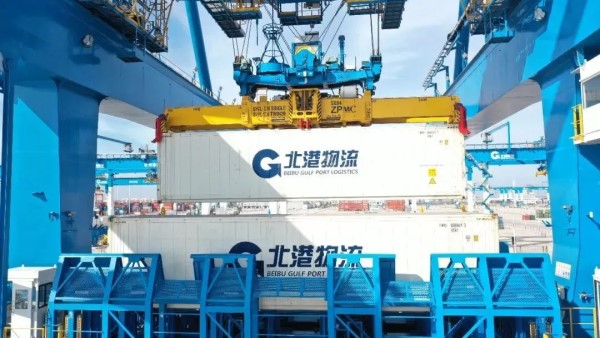
4,132 trains of New Intl Land-Sea Trade Corridor run in H1
In the first half of 2022, 4,132 trains of the New International Land-Sea Trade Corridor ran, transporting 206,758 twenty-foot equivalent units (TEU), a year-on-year increase of 42 percent.
As of June 30, eight new routes have been added to the New International Land-Sea Trade Corridor, including "Sun Village-Beibu Gulf Port," "Chongzuo-Beibu Gulf Port," "Baise-Beibu Gulf Port," and "India-Qinzhou-Dulaying." Its service scope has been expanded to 105 sites in 54 cities in 14 provinces.
In addition, the number of trains in Guangxi Zhuang autonomous region has reached 1,351 as of June 30, an increase of 241 percent year-on-year, helping the sales of Guangxi specialty products.
Thanks to the sea-rail intermodal train, the ore in Guangxi was sent from Baise and Nanning to Beibu Gulf Port, and then transported to Shandong, Tianjin, as well as other eastern regions by sea. In the first half of the year, about 29,268 TEUs of ore were shipped from Guangxi.
White sugar from Chongzuo and Liuzhou is transported to Qinzhou Port through the sea-rail intermodal train and is then shipped to various coastal cities across the country. It has helped reduce transportation costs, and is conducive to the transformation and upgrading of the sugar industry in Guangxi.
In the first half of 2022, the Beibu Gulf port sea-rail combined transport train of the New International Land-Sea Trade Corridor exported 2,922 TEUs of auto parts to Indonesia.
In that period, 29,841 TEUs of grain were shipped from Beibu Gulf Port to Southwest China, providing customers with a green, fast, and safe logistics channel. Through the Sichuan train, 1,400 TEUs of imported soybeans were shipped from Qinzhou Port to Chengdu, with the volume increasing by nearly six times compared with last year.
With the implementation of the RCEP, the Qinzhou Port area of the China (Guangxi) Pilot Free Trade Zone (FTZ) has explored the characteristic sources of foreign trade goods like raw sugar, starch, and wood.
The Qinzhou Port area of the Guangxi FTZ has also opened foreign trade routes, such as "Southeast Asia-Qinzhou-Xi'an," "India-Beibu Gulf Port-Guiyang," and "Australia-Qinzhou-Chengdu," as well as optimized the "Guilin-Beibu Gulf Port-Bangkok," "Liuzhou-Beibu Gulf Port" and the "Jakarta" sea-rail combined transport route, promoting economic cooperation and exchanges between China and ASEAN countries.
In the first half of 2022, 13 RCEP member countries shipped goods through the New International Land-Sea Trade Corridor, with a shipment volume of 35,010 TEUs, accounting for 17 percent of the total volume of the New International Land-Sea Trade Corridor.

Beibu Gulf Port Logistics. [Photo/WeChat account: zmqqzgpq]




